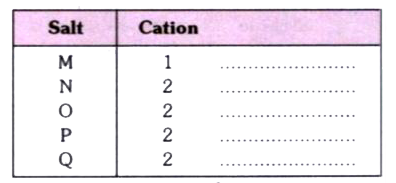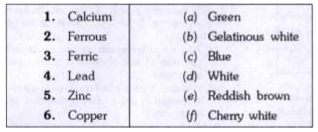Category of compounds which liberate ammonia from ammonium salts :
Acid
Alkali
Salt
Water
To determine the category of compounds that liberate ammonia from ammonium salts, we can follow these steps:
1. Understanding Ammonium Salts: Ammonium salts, such as ammonium chloride (NH4Cl), contain the ammonium ion (NH4+). When these salts react with certain compounds, they can release ammonia (NH3).
2. Identifying the Reaction: The reaction we are interested in is:
NH4Cl+X→NH3+H2O+Y
where X is the compound that will liberate ammonia.
3. Analyzing the Options:
- Acid: Acids typically do not liberate ammonia from ammonium salts; they tend to react with bases.
- Alkali: Alkalis (bases) can react with ammonium salts to produce ammonia. For example, when sodium hydroxide (NaOH) reacts with ammonium chloride (NH4Cl), the reaction is:
NH4Cl+NaOH→NH3+H2O+NaCl
- Salt: Salts do not generally liberate ammonia from ammonium salts.
- Water: Water does not react with ammonium salts to liberate ammonia.
4. Conclusion: Based on the analysis, the category of compounds that liberate ammonia from ammonium salts is alkalis.
Final Answer:
The correct option is alkali.
---
NH4Cl+X→NH3+H2O+Y
where X is the compound that will liberate ammonia.
- Acid: Acids typically do not liberate ammonia from ammonium salts; they tend to react with bases.
- Alkali: Alkalis (bases) can react with ammonium salts to produce ammonia. For example, when sodium hydroxide (NaOH) reacts with ammonium chloride (NH4Cl), the reaction is:
NH4Cl+NaOH→NH3+H2O+NaCl
- Salt: Salts do not generally liberate ammonia from ammonium salts.
- Water: Water does not react with ammonium salts to liberate ammonia.
The correct option is alkali.
Topper's Solved these Questions
- PRACTICAL CHEMISTRY Book:ICSEChapter:PRACTICAL CHEMISTRY Exercise:Additional Questions for Practice
Explore 23 Videos
- PRACTICAL CHEMISTRY Book:ICSEChapter:PRACTICAL CHEMISTRY Exercise:Questions from Previous ICSE Board Papers (2007)
Explore 1 Video
- PRACTICAL CHEMISTRY Book:ICSEChapter:PRACTICAL CHEMISTRY Exercise:WORKSHEET
Explore 1 Video
- PERIODIC TABLE (PERIODIC PROPERTIES AND VARIATION OF PROPERTIES)Book:ICSEChapter:PERIODIC TABLE (PERIODIC PROPERTIES AND VARIATION OF PROPERTIES)Exercise:UNIT TEST PAPER 1-Periodic Table
Explore 22 Videos
- QUESTION PAPER 2022 TERM 1Book:ICSEChapter:QUESTION PAPER 2022 TERM 1Exercise:MULTIPLE CHOICE QUESTIONS
Explore 40 Videos
Similar Questions
Salts A, B, C, D and E undergo reactions (i) to (v) respectively. Identify the anion present in these salts on the basis of these reactions. Tabulate your answers in the format given below:
(i) When silver nitrate solution is added to a solution of A, a white precipitate, insoluble in dilute nitric acid, is formed.
(ii) Addition of dilute hydrochloric acid to B produces a gas which turns lead acetate paper black.
(iii) When a freshly prepared solution of ferrous sulphate is added to a solution of C and concentrated sulphuric acid is gently poured from the side of the test-tube, a brown ring is formed.
(iv) When dilute sulphuric acid is added to D a gas is produced which turns acidified potassium dichromate solution from orange to green.
(v) Addition of dilute hydrochloric acid to E produces an effervescence. The gas produced turns lime water milky but does not affect acidified potassium dichromate solution.

View SolutionSalts M, N, O, P and Q undergo reactiom (i) to (v) respectively.
Identify the cation present in these salts on the basis of these reaction. Tabulate your answer in the format given below.
1. When sodium hydroxide solution is added to the salt M, and heated strongly a colourless gas with a pungent smell is evolved which turm red litmus paper blue and gives dense white fumes with a moist glass rod with hydrochloric acid.
2. Addition of dilute hydrochloric acid to a solution of N gives a thick white precipitate which is soluble in hot water.
3. When ammonium hydroxide solution is added to the solution of 0 a light blue precipitate is obtained which is soluble in excess of ammonium hydroxide to form an inteme deep blue solution.
4. When ammonium hydroxide solution is added to the solution of P reddish brown (mustard colour) precipitate is obtained which ,is insoluble even in the excess of ammonium hydroxide solution.
5. When sodium hydroxide solution is added to the solution of Q a which coloured gelatinous precipitate is obtained which is soluble in excess of sodium hydroxide to form a clear solution

View SolutionMatch the colour of the salts with their ions :

View SolutionIn period 2, element 'A' is to the right of element 'B'.
The element 'A' would probably have a ____ [smaller/larger] atomic size than 'B'.
View SolutionIn the Periodic Table, elements of Period 3 are arranged in the increasing order of ionization potential as:
View SolutionAll ammonium salt liberate ammonia when
View SolutionAmmonium salts on heating with slaked lime liberates a colourless gas (X) . Identify the correct statement for gas (X) and ammonium salt.
View Solution(A) : Ammonium salts evolve ammonia when heated with NaOH.
(R ) : Ammonium salts are soluble in water
View SolutionStatement 1 : Moist ammonium salts give the smell of ammonia on rubbing between the fingers
Statement 2 : Ammonium slats gives ammonia on heating with concentrate NaOH.
View SolutionWhich of the following compounds will not liberate ammonia gas on refluxing with aqueous NaOH?
View SolutionThe ammonium salt which produces ammonia gas on heating is :
View SolutionAll ammonium salts liberate ammonia when :
View SolutionAll ammonium salts on heating with sodium hydroxide produce ammonia gas. From which ammonium salt, can maximum amount of ammonia be obtained ?
View SolutionAmmonium compound which upon heating does not give ammonia is :
View SolutionMagnesium is precipitated from its salt solution as only magnesium ammonium phosphate by adding disodium hydrogen phosphate solution in absence of ammonium chloride and aqueous ammonia.
View Solution